- Joined
- Feb 2, 2011
- Messages
- 2,093
NEW RELEASES FOR DECEMBER 2024
THE ANCIENTS
ARMIES AND ENEMIES OF THE NEW KINGDOM EGYPTIANS
The New Kingdom, is the period in ancient Egyptian history between the sixteenth century BC and the eleventh century BC. It was Egypt’s most prosperous time and marked the peak of its power.
It is also known as the “Ramesside period”, named after the eleven pharaohs who took the name Ramesses, after Ramesses I, the founder of the nineteenth Dynasty.
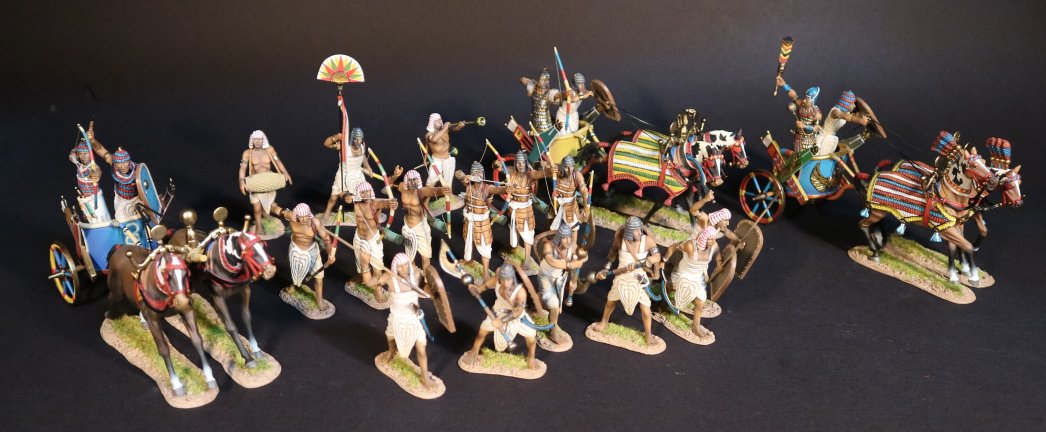
The Egyptians were experts in the use of massed archery.
The infantry was usually divided into two. The archers by now were equipped with the newer composite bow, and would be deployed in linear formation. When faced with lightly protected troops such as the Libyans, massed volleys alone were frequently sufficient to effect the necessary level of destruction.
Archers were an important part of an Egyptian army. They were not generally expected to close with the enemy which is evident by their general lack of body armour.
Against more heavily armed and protected infantry the archers would be employed to deliver heavy covering fire for the close combat infantry known as Nakhtu-aa or “the strong arm boys”.
These would advance rapidly, discharging their spears in the process before closing with an enemy already softened up by the supporting fire of the archers, and attacking with their bronze khopesh swords or long mace axes.
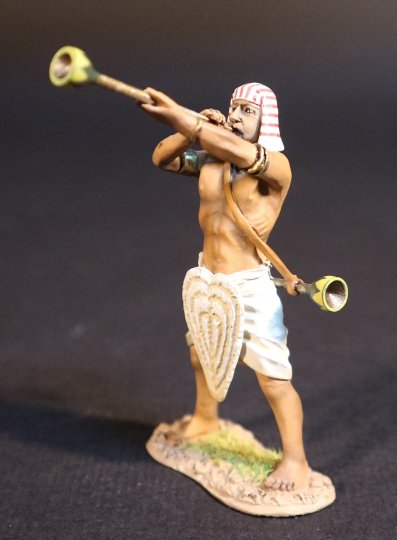
NKE-05A
THE ANCIENTS,
NEW KINGDOM EGYPTIANS,
THE BATTLE OF KADESH 1274BC,
EGYPTIAN MUSICIAN
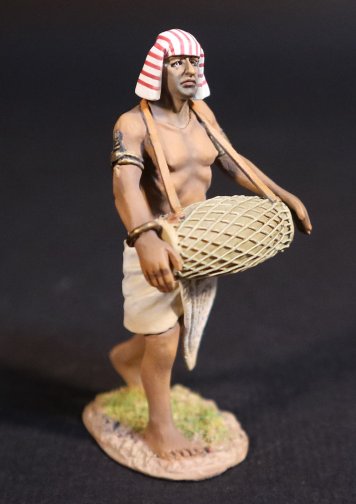
NKE-05B
THE ANCIENTS,
NEW KINGDOM EGYPTIANS,
THE BATTLE OF KADESH 1274BC,
EGYPTIAN DRUMMER
NUBIAN AND LIBYAN MERCENARIES
During the 20th Dynasty Egyptian power declined, and Egypt itself was beset with Libyan incursions and attempted invasions by the sea peoples.

The Libyans were originally composed of two peoples namely the Tehenu and the Temehu. These were later joined by tribes called the Kehek and Meshwesh, the latter being the most notable of all the Libyan tribes.
These peoples never did well against the Egyptians due mainly to their lack of chariots, and were no match for the Egyptians at this time.
The first Libyan War in 1193 BC, Pharaoh Rameses III of the 20th Dynasty fought a mixed army of Libyans and Sea Peoples, which were led by King Themer. The invaders were beaten back with over 12,000 killed and 1,000 taken prisoner.
Libyans wore animal hide cloaks and had dyed ostrich feathers in their hair.
Many Libyans who raided Egypt during the reigns of Merenptah and Ramesses III were captured and impressed as auxiliary troops in the Egyptian army. Ramesses III’s battle scenes illustrate many Libyans armed with bows, as well as long slashing swords traded from the sea peoples.
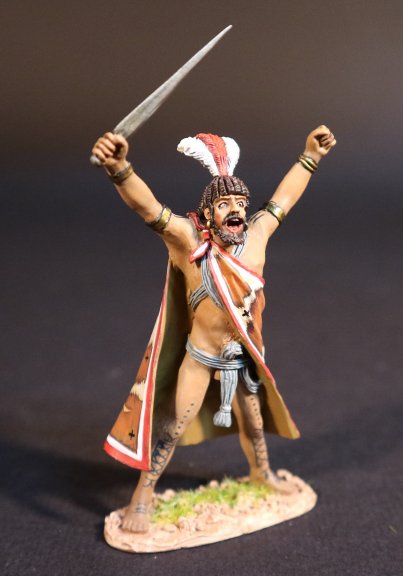
NKE-21
THE ANCIENTS,
NEW KINGDOM EGYPTIANS,
THE BATTLE OF KADESH 1274BC,
LIBYAN MERCENARY
ARMIES AND ENEMIES OF GREECE AND MACEDONIA
MACEDONIAN HYPASPISTS

The Macedonian Hypaspists were positioned on the flank of the Phalangites phalanx.
Their own flanks were protected by light infantry and cavalry.
Their job was to guard the flanks of the large and unwieldy pike phalanx. The armoured phalangites with their sarissas were not particularly agile or able to turn quickly, so hypaspists were positioned to prevent and protect attacks on the vulnerable sides of the phalanx formation.
Their role was vital to the success of the Macedonian tactics because the phalanx was all but invulnerable from the front, and with its layers of iron spikes moving in unison, were used as the anvil in their hammer and anvil tactics. The Companion cavalry was the hammer that smashed the enemy against the anvil of thousands of iron spikes.
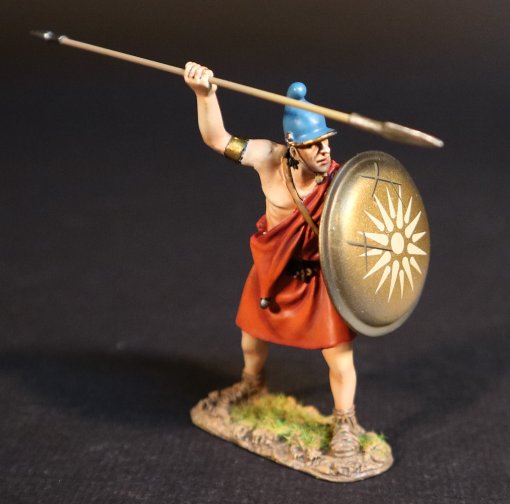
MAC-36A
ARMIES AND ENEMIES OF ANCIENT GREECE AND MACEDONIA,
THE MACEDONIANS,
MACEDONIAN HYPASPIST
The Hypaspists protected the vulnerable phalanx flank, and were able to conduct maneuvers and use tactics, which owing to their hoplite panoply of weapons, would have been impossible to be performed by the phalangites.
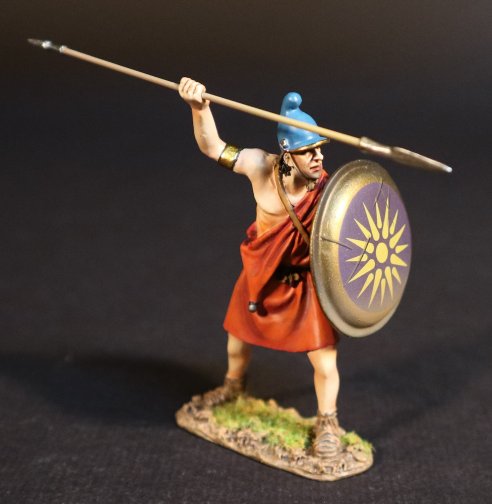
MAC-36B
ARMIES AND ENEMIES OF ANCIENT GREECE AND MACEDONIA,
THE MACEDONIANS,
MACEDONIAN HYPASPIST
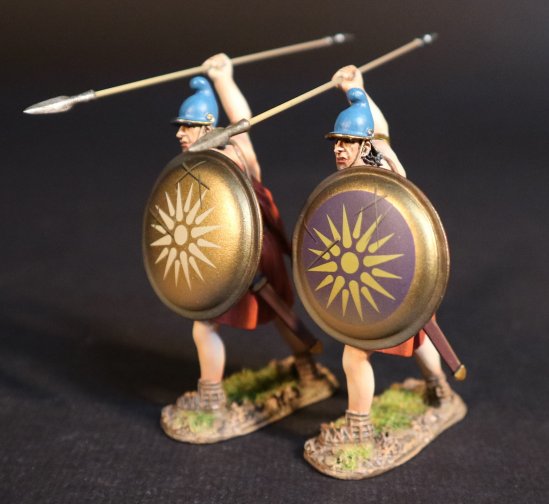
MAC-36N
ARMIES AND ENEMIES OF ANCIENT GREECE AND MACEDONIA,
THE MACEDONIANS,
MACEDONIAN HYPASPISTS
ARMIES AND ENEMIES OF ANCIENT ROME
THE CARTHAGINIANS
CELTIBERIAN SCUTARIUS
Although initially the Carthaginian army was composed only of Citizens of Phoenician origin, it saw increased recruitment of contingents of mercenaries and allies a necessity in order to realize the policy of imperial expansion.
This use of mercenaries saved the metropolitan population from heavy casualties that were not easily replaceable, and it also reflected the Carthaginian concept of war, which was considered simply as an extension of business.
With the enlargement of Punic economic interests the army became more exclusively mercenary and progressively came to include almost all the peoples of the central and western Mediterranean area.
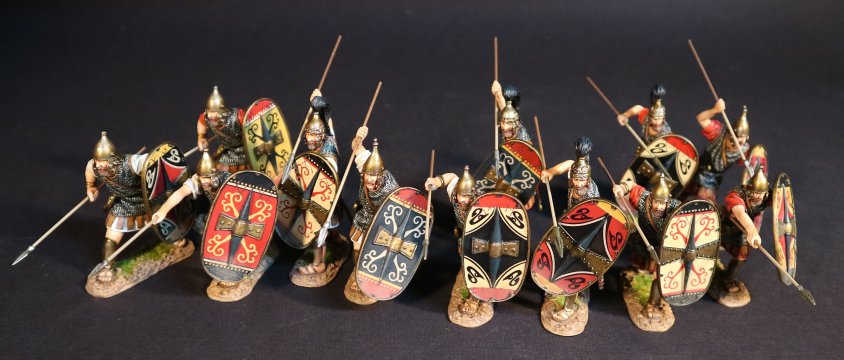
The success of Carthage in bringing most of central and southern Iberia under its control was a crucial element in their continued ability to pursue the war against Rome.
Iberian troops probably fell into two rough classifications, the Scutarii and the Caetratii.
These types basically defined the type of shield, with the Scutum being a large flat oval shield with a wooden spine and metal boss.
The Caetra was a flat, smaller round shield with a circular metal boss.
Both troop types were armed with a dagger and sword, as well as spears for hand to hand fighting and for throwing.
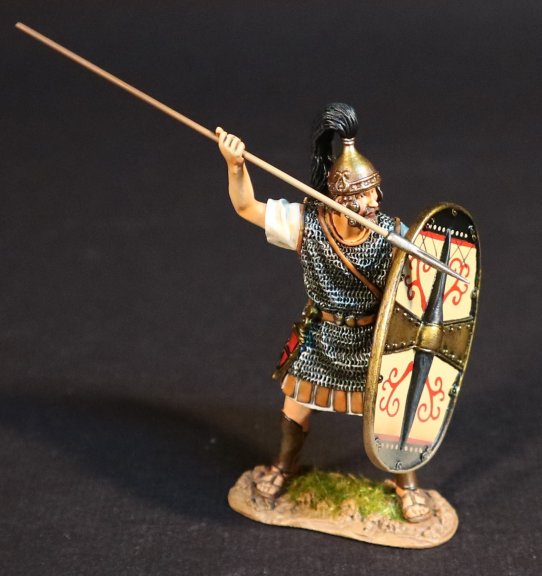
CTIB-01A
ARMIES AND ENEMIES OF ANCIENT ROME,
THE CARTHAGINIANS,
CELTIBARIAN SCUTARII
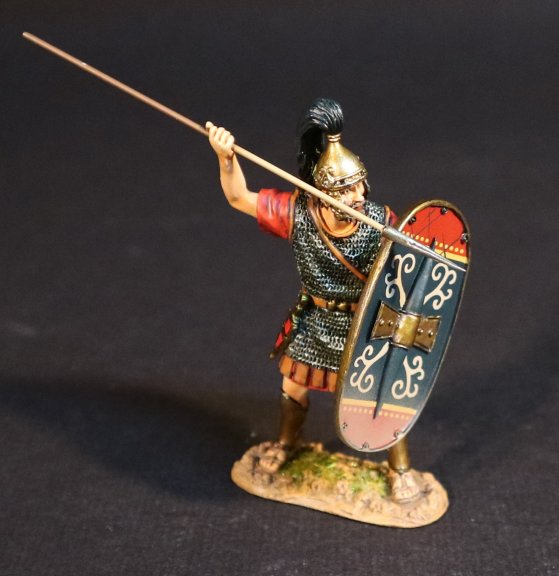
CTIB-01B
ARMIES AND ENEMIES OF ANCIENT ROME,
THE CARTHAGINIANS,
CELTIBARIAN SCUTARII
The Scutarius were well armoured heavy infantry, and the Celtibarians were mainly from the north, and were heavily influenced by their Gallic neighbours. Those who fought with Hannibal would have been mercenaries, and in organization and military effectiveness would have been much the same as the Gauls. They were known to be fierce, independent and dangerous.
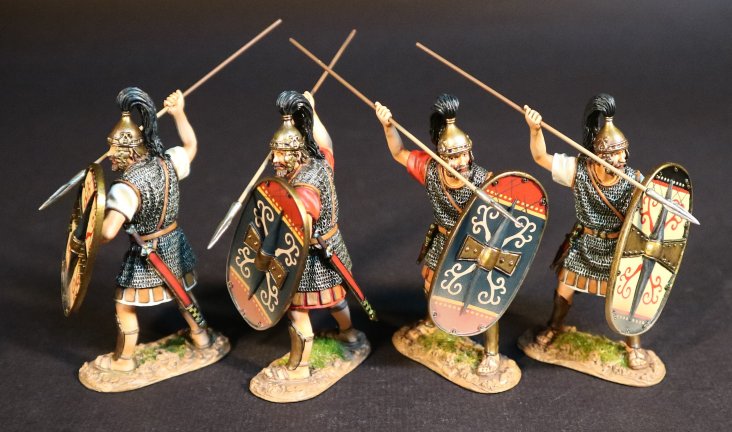
CTIB-01N
ARMIES AND ENEMIES OF ANCIENT ROME,
THE CARTHAGINIANS,
CELTIBARIAN SCUTARIUS
THE TROJAN WAR
TROY AND HER ALLIES
KING PRIAM OF TROY
Priam was the legendary and last king of Troy during the Trojan War. He was the son of Laomedon. The many children of Priam , included notable characters such as Hector , Paris, and Cassandra.
Initially Priam was named Podarces, and his change of name has to do with the actions of the Greek hero Heracles and Priam’s father, Laomedon.
Heracles came to Troy when the city was under attack by disease and a sea monster, the attacks being the retribution of Poseidon and Apollo, after Laomedon had refused to pay them for work done. Heracles promised Laomedon to free Troy from the attacks, if the king would promise to give him the swift horses of Troy in payment.
Laomedon agreed to the deal and on the beach outside of Troy, Heracles slew the sea monster after three days of fighting. With the death of the monster, the pestilence also left Troy, but when Heracles went to Laomedon to take payment, the king refused and locked the city gates against the hero.
Heracles would later return to Troy with several ships of men, including Telamon, and the hero laid siege to the city. Heracles would eventually enter the city, and the Greek hero killed Laomedon. The sons of the king were also killed by Heracles, until only the youngest, Podarces was left alive. He too would have died at the hands of Heracles, but Hesione, the sister of Podarces, stayed the hand of Heracles, by offering up a ransom for her brother; the ransom taking the form of a golden veil. Podarces would then take the name Priam, meaning “ransomed”.
Having had his life spared, Priam then found himself elevated to king status, for Heracles put the Trojan prince upon the throne, making him ruler of Troy.
Troy would prosper under the leadership of Priam, the city’s walls were rebuilt, and the military strength of Troy would grow. Priam was even said to have led the forces of Troy when allied with the Phrygians in a war against the Amazons.
As money flowed into Troy, through trade, so Priam built himself a magnificent palace; A palace built from brilliant white marble, comprising many hundreds of different rooms.
Priam is killed during the sack of troy, by Achilles’ son Neoptolemus. In Virgil’s description, Neoptolemus first kills Priam’s son Polites in front of his father as he seeks sanctuary on the altar of Zeus. Priam rebukes Neoptolemus, throwing a spear at him, harmlessly hitting his shield. Priam is then dragged by Neoptolemus to the altar and there kills him.
Priam’s death is alternatively depicted on some Greek vases, where Neoptolemus clubs Priam to death with the corpse of the latter’s baby grandson, Astyanax.
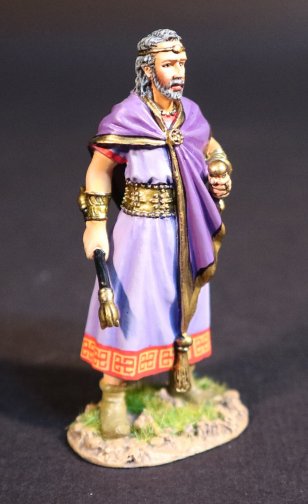
TWT-01
THE TROJAN WAR,
TROY AND HER ALLIES,
KING PRIAM OF TROY
ANCIENT GERMANS
Following two decades of Roman occupation, Germania Magna erupted into revolt in AD 9, resulting in the stunning loss of three Roman legions to an alliance of Germanic nations at Teutoburg. The Battle of the Teutoburg Forest, described as the Varian Disaster by Roman historians, took place in the Teutoburg Forest in 9 CE, when an alliance of Germanic tribes ambushed and decisively destroyed three Roman legions and their auxiliaries, led by Publius Quinctilius Varus.
The alliance was led by Arminius, a Germanic officer of Varus' auxilia. Arminius had acquired Roman citizenship and had received a Roman military education, which enabled him to deceive the Roman commander methodically and anticipate the Roman army's tactical responses.
Despite several successful campaigns and raids by the Romans in the years after the battle, they never again attempted to conquer the Germanic territories east of the Rhine river. The victory of the Germanic tribes against Rome's legions in the Teutoburg Forest would have far-reaching effects on the subsequent history of both the ancient Germanic peoples and the Roman Empire. Contemporary and modern historians have generally regarded Arminius' victory over Varus as "Rome's greatest defeat", one of the most decisive battles recorded in military history, and as "a turning-point in world history".
The Germanic warrior was a well trained, battle-hardened, combat ready and motivated fighter, who excelled in irregular warfare, ambushes, raids and petty warfare. In an ambush the lightly armed Germanic fighter could decisively defeat a heavily equipped legionary by using surprise and the terrain to his advantage.
These warriors were perfectly equipped for the Germanic landscape of open fields, forests and swamps. The weapons which were used included the long lance or Framea, which could be swung, thrust or thrown at an opponent.
Hair was grown long and often tied up in a figure of eight or “Suebian” knot.
In a set-piece battle the German could stand up to the Roman Legionary discipline and formations for a while, but in close quarters combat the advantage eventually shifted to the legionary.
GERMANIC WARRIOR WOMEN
For the Romans, ethnographic observations were often a by-product of campaigning. All the more is it noteworthy that Roman historians repeatedly delve into descriptions of the warlike nature of Germanic women.
The most common involvement of women in combat seems to have been in the defence of the wagon fort. Germanic tribes used laagers to protect their baggage and sometimes also as a defensive tactic in itself. For example, at the battle of Adrianople (378 AD), the Goths formed up behind a circular ring of wagons.
When an army was beaten and the enemy moved against the wagon fort, the women and sometimes even the children entrenched there often put up a fierce fight. Plutarch writes about one of Caesar’s battles against the Helvetians:
“After a long and hard struggle he routed the enemy’s fighting men, but had the most trouble at their rampart of waggons, where not only did the men themselves make a stand and fight, but also their wives and children defended themselves to the death and were cut to pieces with the men.” (Plutarch, Life of Caesar 18)
Scenes like this seem to have happened often, as they can be found in several sources. This of course if not surprising if one considers that surrender would have meant slavery at the best.
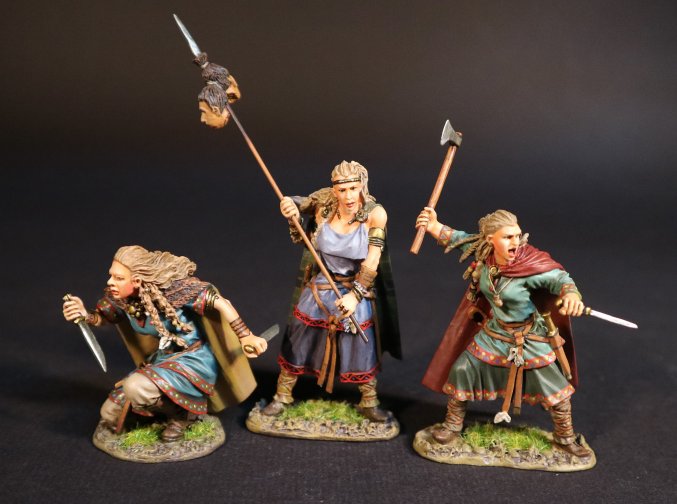
Germanic women were forced to defend the wagon trains after many battles against the Romans.
If a tribe was caught up in a fight while migrating or moving for any reason, women would not be left behind. Germanic women would yell at their fighting men, sometimes with their children on hand to witness the fighting. The women encouraged their children to yell and, with bare breasts, shouted reminders at the men that they must be victorious in combat or their families would be captured and enslaved… or worse, slaughtered wholesale.
Their shouts encouraged their men to fight harder, as women were considered holy spirits. Letting them fall into enemy hands was the ultimate failure.
The Roman Senator and historian Tacitus wrote in his work, Germania:
“A specially powerful incitement to valor is that the squadrons and divisions are not made up at random by the mustering of chance-comers, but are each composed of men of one family or clan. Close by them, too, are their nearest and dearest, so that they can hear the shrieks of their women-folk and the wailing of their children. These are the witnesses whom each man reverences most highly, whose praise he most desires. It is to their mothers and wives that they go to have their wounds treated, and the women are not afraid to count and compare the gashes. They also carry supplies of food to the combatants and encourage them.
It stands on record that armies already wavering and on the point of collapse have been rallied by the women, pleading heroically with their men, thrusting forward their bared bosoms, and making them realize the imminent prospect of enslavement - a fate which the Germans fear more desperately for their women than for themselves. Indeed, you can secure a surer hold on these nations if you compel them to include among a consignment of hostages some girls of noble family. More than this, they believe that there resides in women an element of holiness and a gift of prophecy; and so they do not scorn to ask their advice, or lightly disregard their replies. The women were more than just morale builders, though. They provided aid and comfort to their men after the battle was over, of course. And they would bring supplies and food to their male warriors in the middle of the fight.”
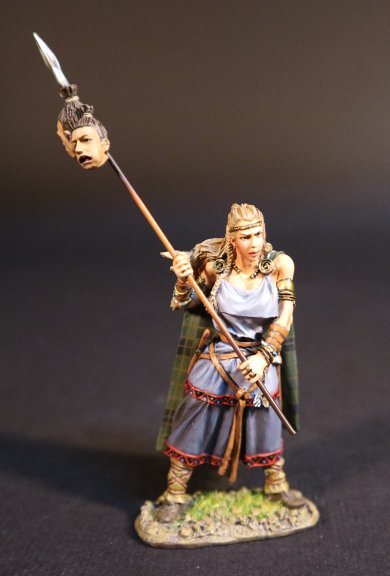
AG-14
ARMIES AND ENEMIES OF ANCIENT ROME,
GERMANIC WARRIORS,
GERMANIC WARRIOR WOMAN
If the battle didn’t go well, however, Germanic women could take on an entirely new role. They might kill any male members of the tribe who attempted retreat. They could even kill their children and then commit suicide rather than submit to enslavement by another tribe or army.
** PLEASE CONTACT YOUR LOCAL DEALER FOR FURTHER INFORMATION **
THE ANCIENTS
ARMIES AND ENEMIES OF THE NEW KINGDOM EGYPTIANS
The New Kingdom, is the period in ancient Egyptian history between the sixteenth century BC and the eleventh century BC. It was Egypt’s most prosperous time and marked the peak of its power.
It is also known as the “Ramesside period”, named after the eleven pharaohs who took the name Ramesses, after Ramesses I, the founder of the nineteenth Dynasty.

The Egyptians were experts in the use of massed archery.
The infantry was usually divided into two. The archers by now were equipped with the newer composite bow, and would be deployed in linear formation. When faced with lightly protected troops such as the Libyans, massed volleys alone were frequently sufficient to effect the necessary level of destruction.
Archers were an important part of an Egyptian army. They were not generally expected to close with the enemy which is evident by their general lack of body armour.
Against more heavily armed and protected infantry the archers would be employed to deliver heavy covering fire for the close combat infantry known as Nakhtu-aa or “the strong arm boys”.
These would advance rapidly, discharging their spears in the process before closing with an enemy already softened up by the supporting fire of the archers, and attacking with their bronze khopesh swords or long mace axes.

NKE-05A
THE ANCIENTS,
NEW KINGDOM EGYPTIANS,
THE BATTLE OF KADESH 1274BC,
EGYPTIAN MUSICIAN

NKE-05B
THE ANCIENTS,
NEW KINGDOM EGYPTIANS,
THE BATTLE OF KADESH 1274BC,
EGYPTIAN DRUMMER
NUBIAN AND LIBYAN MERCENARIES
During the 20th Dynasty Egyptian power declined, and Egypt itself was beset with Libyan incursions and attempted invasions by the sea peoples.

The Libyans were originally composed of two peoples namely the Tehenu and the Temehu. These were later joined by tribes called the Kehek and Meshwesh, the latter being the most notable of all the Libyan tribes.
These peoples never did well against the Egyptians due mainly to their lack of chariots, and were no match for the Egyptians at this time.
The first Libyan War in 1193 BC, Pharaoh Rameses III of the 20th Dynasty fought a mixed army of Libyans and Sea Peoples, which were led by King Themer. The invaders were beaten back with over 12,000 killed and 1,000 taken prisoner.
Libyans wore animal hide cloaks and had dyed ostrich feathers in their hair.
Many Libyans who raided Egypt during the reigns of Merenptah and Ramesses III were captured and impressed as auxiliary troops in the Egyptian army. Ramesses III’s battle scenes illustrate many Libyans armed with bows, as well as long slashing swords traded from the sea peoples.

NKE-21
THE ANCIENTS,
NEW KINGDOM EGYPTIANS,
THE BATTLE OF KADESH 1274BC,
LIBYAN MERCENARY
ARMIES AND ENEMIES OF GREECE AND MACEDONIA
MACEDONIAN HYPASPISTS

The Macedonian Hypaspists were positioned on the flank of the Phalangites phalanx.
Their own flanks were protected by light infantry and cavalry.
Their job was to guard the flanks of the large and unwieldy pike phalanx. The armoured phalangites with their sarissas were not particularly agile or able to turn quickly, so hypaspists were positioned to prevent and protect attacks on the vulnerable sides of the phalanx formation.
Their role was vital to the success of the Macedonian tactics because the phalanx was all but invulnerable from the front, and with its layers of iron spikes moving in unison, were used as the anvil in their hammer and anvil tactics. The Companion cavalry was the hammer that smashed the enemy against the anvil of thousands of iron spikes.

MAC-36A
ARMIES AND ENEMIES OF ANCIENT GREECE AND MACEDONIA,
THE MACEDONIANS,
MACEDONIAN HYPASPIST
The Hypaspists protected the vulnerable phalanx flank, and were able to conduct maneuvers and use tactics, which owing to their hoplite panoply of weapons, would have been impossible to be performed by the phalangites.

MAC-36B
ARMIES AND ENEMIES OF ANCIENT GREECE AND MACEDONIA,
THE MACEDONIANS,
MACEDONIAN HYPASPIST

MAC-36N
ARMIES AND ENEMIES OF ANCIENT GREECE AND MACEDONIA,
THE MACEDONIANS,
MACEDONIAN HYPASPISTS
ARMIES AND ENEMIES OF ANCIENT ROME
THE CARTHAGINIANS
CELTIBERIAN SCUTARIUS
Although initially the Carthaginian army was composed only of Citizens of Phoenician origin, it saw increased recruitment of contingents of mercenaries and allies a necessity in order to realize the policy of imperial expansion.
This use of mercenaries saved the metropolitan population from heavy casualties that were not easily replaceable, and it also reflected the Carthaginian concept of war, which was considered simply as an extension of business.
With the enlargement of Punic economic interests the army became more exclusively mercenary and progressively came to include almost all the peoples of the central and western Mediterranean area.

The success of Carthage in bringing most of central and southern Iberia under its control was a crucial element in their continued ability to pursue the war against Rome.
Iberian troops probably fell into two rough classifications, the Scutarii and the Caetratii.
These types basically defined the type of shield, with the Scutum being a large flat oval shield with a wooden spine and metal boss.
The Caetra was a flat, smaller round shield with a circular metal boss.
Both troop types were armed with a dagger and sword, as well as spears for hand to hand fighting and for throwing.

CTIB-01A
ARMIES AND ENEMIES OF ANCIENT ROME,
THE CARTHAGINIANS,
CELTIBARIAN SCUTARII

CTIB-01B
ARMIES AND ENEMIES OF ANCIENT ROME,
THE CARTHAGINIANS,
CELTIBARIAN SCUTARII
The Scutarius were well armoured heavy infantry, and the Celtibarians were mainly from the north, and were heavily influenced by their Gallic neighbours. Those who fought with Hannibal would have been mercenaries, and in organization and military effectiveness would have been much the same as the Gauls. They were known to be fierce, independent and dangerous.

CTIB-01N
ARMIES AND ENEMIES OF ANCIENT ROME,
THE CARTHAGINIANS,
CELTIBARIAN SCUTARIUS
THE TROJAN WAR
TROY AND HER ALLIES
KING PRIAM OF TROY
Priam was the legendary and last king of Troy during the Trojan War. He was the son of Laomedon. The many children of Priam , included notable characters such as Hector , Paris, and Cassandra.
Initially Priam was named Podarces, and his change of name has to do with the actions of the Greek hero Heracles and Priam’s father, Laomedon.
Heracles came to Troy when the city was under attack by disease and a sea monster, the attacks being the retribution of Poseidon and Apollo, after Laomedon had refused to pay them for work done. Heracles promised Laomedon to free Troy from the attacks, if the king would promise to give him the swift horses of Troy in payment.
Laomedon agreed to the deal and on the beach outside of Troy, Heracles slew the sea monster after three days of fighting. With the death of the monster, the pestilence also left Troy, but when Heracles went to Laomedon to take payment, the king refused and locked the city gates against the hero.
Heracles would later return to Troy with several ships of men, including Telamon, and the hero laid siege to the city. Heracles would eventually enter the city, and the Greek hero killed Laomedon. The sons of the king were also killed by Heracles, until only the youngest, Podarces was left alive. He too would have died at the hands of Heracles, but Hesione, the sister of Podarces, stayed the hand of Heracles, by offering up a ransom for her brother; the ransom taking the form of a golden veil. Podarces would then take the name Priam, meaning “ransomed”.
Having had his life spared, Priam then found himself elevated to king status, for Heracles put the Trojan prince upon the throne, making him ruler of Troy.
Troy would prosper under the leadership of Priam, the city’s walls were rebuilt, and the military strength of Troy would grow. Priam was even said to have led the forces of Troy when allied with the Phrygians in a war against the Amazons.
As money flowed into Troy, through trade, so Priam built himself a magnificent palace; A palace built from brilliant white marble, comprising many hundreds of different rooms.
Priam is killed during the sack of troy, by Achilles’ son Neoptolemus. In Virgil’s description, Neoptolemus first kills Priam’s son Polites in front of his father as he seeks sanctuary on the altar of Zeus. Priam rebukes Neoptolemus, throwing a spear at him, harmlessly hitting his shield. Priam is then dragged by Neoptolemus to the altar and there kills him.
Priam’s death is alternatively depicted on some Greek vases, where Neoptolemus clubs Priam to death with the corpse of the latter’s baby grandson, Astyanax.

TWT-01
THE TROJAN WAR,
TROY AND HER ALLIES,
KING PRIAM OF TROY
ANCIENT GERMANS
Following two decades of Roman occupation, Germania Magna erupted into revolt in AD 9, resulting in the stunning loss of three Roman legions to an alliance of Germanic nations at Teutoburg. The Battle of the Teutoburg Forest, described as the Varian Disaster by Roman historians, took place in the Teutoburg Forest in 9 CE, when an alliance of Germanic tribes ambushed and decisively destroyed three Roman legions and their auxiliaries, led by Publius Quinctilius Varus.
The alliance was led by Arminius, a Germanic officer of Varus' auxilia. Arminius had acquired Roman citizenship and had received a Roman military education, which enabled him to deceive the Roman commander methodically and anticipate the Roman army's tactical responses.
Despite several successful campaigns and raids by the Romans in the years after the battle, they never again attempted to conquer the Germanic territories east of the Rhine river. The victory of the Germanic tribes against Rome's legions in the Teutoburg Forest would have far-reaching effects on the subsequent history of both the ancient Germanic peoples and the Roman Empire. Contemporary and modern historians have generally regarded Arminius' victory over Varus as "Rome's greatest defeat", one of the most decisive battles recorded in military history, and as "a turning-point in world history".
The Germanic warrior was a well trained, battle-hardened, combat ready and motivated fighter, who excelled in irregular warfare, ambushes, raids and petty warfare. In an ambush the lightly armed Germanic fighter could decisively defeat a heavily equipped legionary by using surprise and the terrain to his advantage.
These warriors were perfectly equipped for the Germanic landscape of open fields, forests and swamps. The weapons which were used included the long lance or Framea, which could be swung, thrust or thrown at an opponent.
Hair was grown long and often tied up in a figure of eight or “Suebian” knot.
In a set-piece battle the German could stand up to the Roman Legionary discipline and formations for a while, but in close quarters combat the advantage eventually shifted to the legionary.
GERMANIC WARRIOR WOMEN
For the Romans, ethnographic observations were often a by-product of campaigning. All the more is it noteworthy that Roman historians repeatedly delve into descriptions of the warlike nature of Germanic women.
The most common involvement of women in combat seems to have been in the defence of the wagon fort. Germanic tribes used laagers to protect their baggage and sometimes also as a defensive tactic in itself. For example, at the battle of Adrianople (378 AD), the Goths formed up behind a circular ring of wagons.
When an army was beaten and the enemy moved against the wagon fort, the women and sometimes even the children entrenched there often put up a fierce fight. Plutarch writes about one of Caesar’s battles against the Helvetians:
“After a long and hard struggle he routed the enemy’s fighting men, but had the most trouble at their rampart of waggons, where not only did the men themselves make a stand and fight, but also their wives and children defended themselves to the death and were cut to pieces with the men.” (Plutarch, Life of Caesar 18)
Scenes like this seem to have happened often, as they can be found in several sources. This of course if not surprising if one considers that surrender would have meant slavery at the best.

Germanic women were forced to defend the wagon trains after many battles against the Romans.
If a tribe was caught up in a fight while migrating or moving for any reason, women would not be left behind. Germanic women would yell at their fighting men, sometimes with their children on hand to witness the fighting. The women encouraged their children to yell and, with bare breasts, shouted reminders at the men that they must be victorious in combat or their families would be captured and enslaved… or worse, slaughtered wholesale.
Their shouts encouraged their men to fight harder, as women were considered holy spirits. Letting them fall into enemy hands was the ultimate failure.
The Roman Senator and historian Tacitus wrote in his work, Germania:
“A specially powerful incitement to valor is that the squadrons and divisions are not made up at random by the mustering of chance-comers, but are each composed of men of one family or clan. Close by them, too, are their nearest and dearest, so that they can hear the shrieks of their women-folk and the wailing of their children. These are the witnesses whom each man reverences most highly, whose praise he most desires. It is to their mothers and wives that they go to have their wounds treated, and the women are not afraid to count and compare the gashes. They also carry supplies of food to the combatants and encourage them.
It stands on record that armies already wavering and on the point of collapse have been rallied by the women, pleading heroically with their men, thrusting forward their bared bosoms, and making them realize the imminent prospect of enslavement - a fate which the Germans fear more desperately for their women than for themselves. Indeed, you can secure a surer hold on these nations if you compel them to include among a consignment of hostages some girls of noble family. More than this, they believe that there resides in women an element of holiness and a gift of prophecy; and so they do not scorn to ask their advice, or lightly disregard their replies. The women were more than just morale builders, though. They provided aid and comfort to their men after the battle was over, of course. And they would bring supplies and food to their male warriors in the middle of the fight.”

AG-14
ARMIES AND ENEMIES OF ANCIENT ROME,
GERMANIC WARRIORS,
GERMANIC WARRIOR WOMAN
If the battle didn’t go well, however, Germanic women could take on an entirely new role. They might kill any male members of the tribe who attempted retreat. They could even kill their children and then commit suicide rather than submit to enslavement by another tribe or army.
** PLEASE CONTACT YOUR LOCAL DEALER FOR FURTHER INFORMATION **

